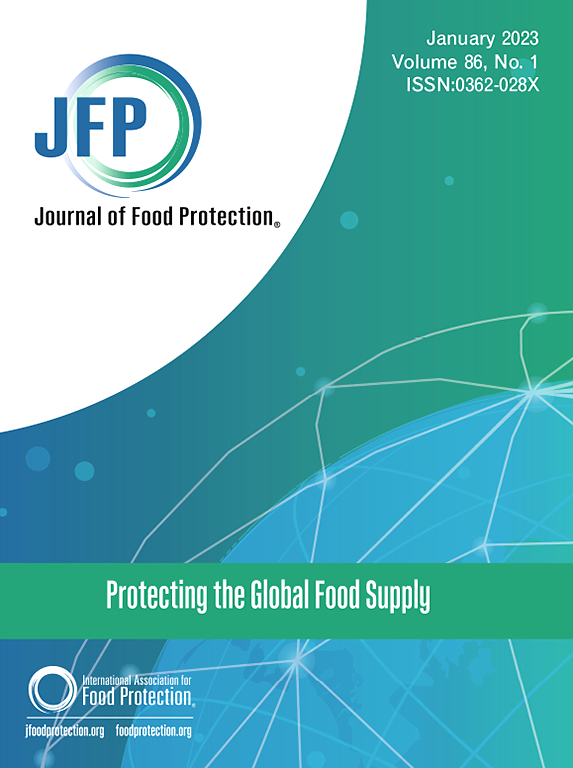美国预防诺如病毒爆发的国家食品安全法的最新评估。
IF 2.8
4区 农林科学
Q3 BIOTECHNOLOGY & APPLIED MICROBIOLOGY
引用次数: 0
摘要
食源性诺如病毒暴发通常与患病员工在准备过程中造成的食品污染有关。美国食品和药物管理局的食品法典概述了食品安全条款,以防止疾病在食品场所传播。《食品法典》每四年发布一次更新的完整版本;具体条款的采纳由州政府自行决定。截至2020年3月,对50个州和哥伦比亚特区(51个司法管辖区)的食品安全法进行了评估,以通过2017年《食品法典》中包含的四项与诺如病毒相关的条款:1)禁止赤脚接触即食食品(RTE), 2)排除呕吐或腹泻的食品员工,3)负责人是经过认证的食品保护经理(CFPM),以及4)呕吐或腹泻事件的书面应对计划。我们将2017年食品法典条款的采用频率与之前对2013年食品法典条款采用情况的评估进行了比较。45个司法管辖区(88%)采取了禁止徒手接触RTE食品的措施,比之前分析的39个司法管辖区(76%)有所增加。40个司法管辖区(78%)要求在症状停止后≥24小时内排除呕吐或腹泻的食品员工,比30个司法管辖区(59%)有所增加。2017年《食品法典》新增了要求负责人为CFPM和污染事件书面应对计划的规定;5个司法管辖区(10%)要求负责人为CFPM, 9个(18%)要求书面回应计划。禁止赤手接触RTE食品和要求排除不良食品雇员的规定增加了。更新的规定,要求一个负责人作为CFPM和书面的污染应对计划,没有被广泛采用。更多地采用《食品法典》条款和改进遵守情况可减少诺如病毒在食品场所的传播。本文章由计算机程序翻译,如有差异,请以英文原文为准。
Updated Assessment of State Food Safety Laws for Norovirus Outbreak Prevention in the United States
Foodborne norovirus outbreaks are often associated with food contamination during preparation by an ill employee. The US Food and Drug Administration’s Food Code outlines food safety provisions to prevent illness transmission in food establishments. An updated full version of the Food Code is released every four years; adoption of specific provisions is at the discretion of state governments.
Food safety laws of the 50 states and District of Columbia (51 jurisdictions) were assessed for adoption as of March 2020, of four norovirus-related provisions included in the 2017 Food Code: (1) prohibition of barehand contact with ready-to-eat (RTE) food, (2) exclusion of food employees with vomiting or diarrhea, (3) person in charge being a certified food protection manager (CFPM), and (4) written response plan for vomiting or diarrheal events. We compared the frequency of adoption of the 2017 Food Code provisions to a previous assessment of adoption of these provisions in the 2013 Food Code.
Prohibition of barehand contact with RTE food was adopted by 45 jurisdictions (88%), an increase from 39 jurisdictions (76%) in the previous analysis. Forty jurisdictions (78%) required exclusion of food employees with vomiting or diarrhea for ≥24 h after symptom cessation, an increase from 30 jurisdictions (59%). Provisions requiring the person in charge to be a CFPM and written response plan for contamination events were new to the 2017 Food Code; 5 jurisdictions (10%) required the person in charge to be a CFPM and 9 (18%) required a written response plan.
Adoption of provisions prohibiting barehand contact with RTE food and requiring exclusion of ill food employees increased. Newer provisions, requiring a person in charge to be a CFPM and a written contamination response plan, were not as widely adopted. Increased adoption of Food Code provisions and improved compliance may decrease norovirus transmission in food establishments.
求助全文
通过发布文献求助,成功后即可免费获取论文全文。
去求助
来源期刊

Journal of food protection
工程技术-生物工程与应用微生物
CiteScore
4.20
自引率
5.00%
发文量
296
审稿时长
2.5 months
期刊介绍:
The Journal of Food Protection® (JFP) is an international, monthly scientific journal in the English language published by the International Association for Food Protection (IAFP). JFP publishes research and review articles on all aspects of food protection and safety. Major emphases of JFP are placed on studies dealing with:
Tracking, detecting (including traditional, molecular, and real-time), inactivating, and controlling food-related hazards, including microorganisms (including antibiotic resistance), microbial (mycotoxins, seafood toxins) and non-microbial toxins (heavy metals, pesticides, veterinary drug residues, migrants from food packaging, and processing contaminants), allergens and pests (insects, rodents) in human food, pet food and animal feed throughout the food chain;
Microbiological food quality and traditional/novel methods to assay microbiological food quality;
Prevention of food-related hazards and food spoilage through food preservatives and thermal/non-thermal processes, including process validation;
Food fermentations and food-related probiotics;
Safe food handling practices during pre-harvest, harvest, post-harvest, distribution and consumption, including food safety education for retailers, foodservice, and consumers;
Risk assessments for food-related hazards;
Economic impact of food-related hazards, foodborne illness, food loss, food spoilage, and adulterated foods;
Food fraud, food authentication, food defense, and foodborne disease outbreak investigations.
 求助内容:
求助内容: 应助结果提醒方式:
应助结果提醒方式:


